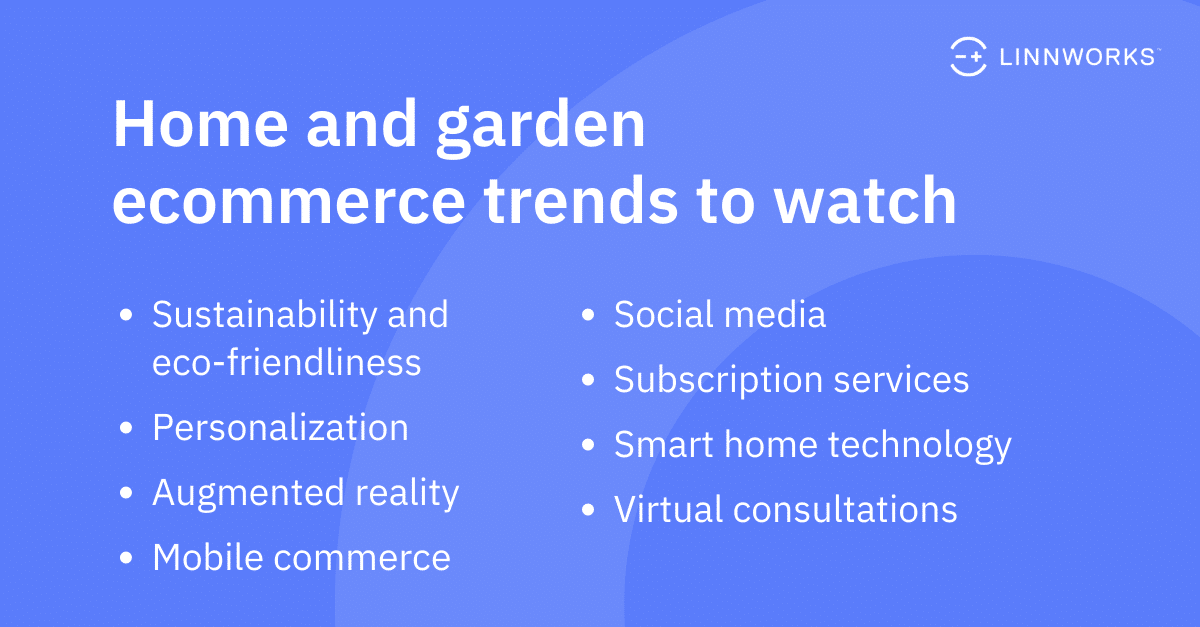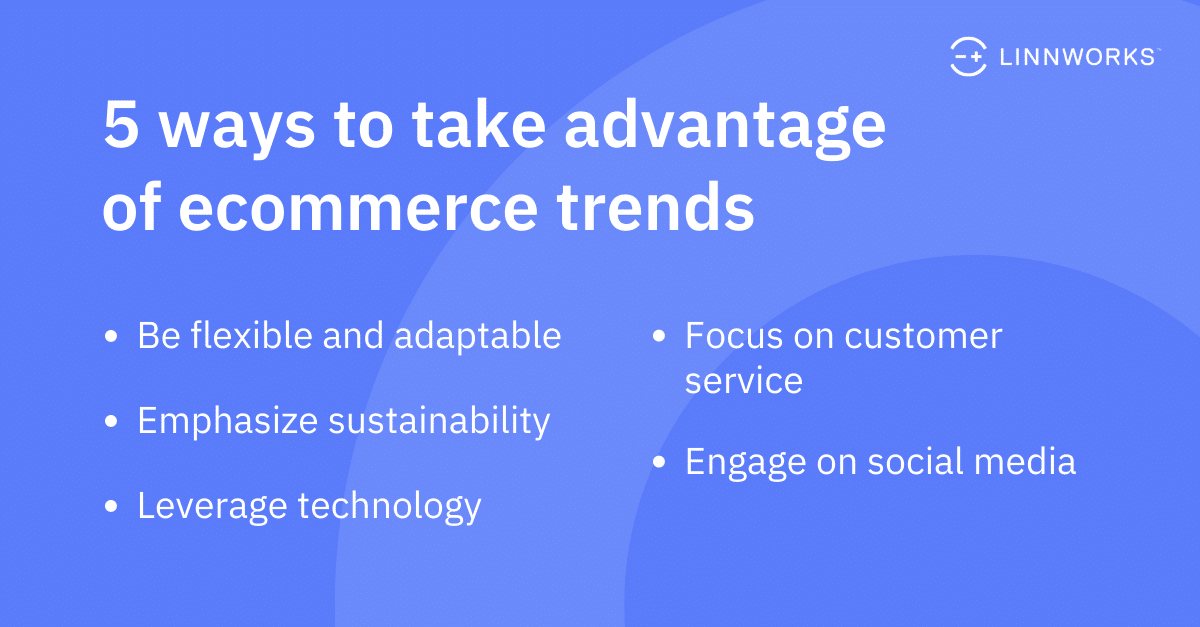Top Home and Garden Ecommerce Trends to Watch
Home and garden sellers need a special combination of knowledge, skills and tools to succeed.
Customers expect the convenience of online shopping and fast, simple delivery. But most sales involve live inventory that requires special care and attention, especially during transport. Succeeding in home and garden ecommerce starts by understanding the industry’s unique product and customer needs.
The emergence of omnichannel retailing requires businesses to have a multifaceted online presence and a deep understanding of consumer behavior across channels. Home and garden sellers must do all that while mastering the particulars of their industry.
Learn more about the top home and garden ecommerce trends and how you can apply them to your business.
Home and garden ecommerce trends you should watch
The home and garden ecommerce industry has seen incredible growth in recent years and will continue to grow. One forecast expects the business-to-consumer home and garden market to experience 10.53% compound annual growth through 2027. Factors driving this growth include the convenience of online shopping and the popularity of do-it-yourself home projects.
While major retailers such as Lowe’s, Home Depot and Williams-Sonoma will benefit from this growth, there’s plenty of opportunity for retailers of all sizes to thrive. Here are some important home and garden ecommerce trends that will affect your operations, sales and customer experience.
Sustainability and eco-friendliness
With more people becoming environmentally conscious, there’s a growing demand for sustainable and eco-friendly products.
This trend is likely to continue in the home and garden category, with customers looking for energy-efficient products made from recycled or sustainable materials toreduce waste.
Customers are also looking for eco-friendly packaging and shipping. This includes minimal packaging materials, biodegradable or compostable packaging, and carbon-neutral shipping methods.
Personalization
Increasingly, customers want personalized experiences when shopping online. This includes tailored product recommendations, offers and promotions, and customized home and garden design services.
In the home and garden category, personalization includes recommendations based on purchase history and preferences, as well as design services that consider the unique features and layout of the customer’s home or outdoor space.
Augmented reality
Augmented reality (AR) technology is becoming popular for online retailers, especially when customers want to visualize what they’re buying but can’t view the product in person. The home and garden category is no exception.
AR enables customers to visualize how products will look in their home, garden or other outdoor space before making a purchase. AR is an improvement on static photos, allowing customers to virtually interact with and explore products, which increases their confidence in making a purchase and reduces the likelihood of complaints or returns.
Virtual consultations
As people do more of their shopping online, they want to be sure of what they’re buying even if they can’t see it in person or talk to a professional. A growing trend, virtual consultations help these customers move closer to a purchasing decision.
With virtual consultations, customers can speak with design experts or home and garden professionals on demand to receive personalized advice and guidance. This can help customers feel more confident and lead to higher conversion rates.
Mobile commerce
Mobile shopping is firmly established across categories, including home and garden. It’s no longer optional for your online to be optimized for mobile use, whether that’s in a browser or an app. Your brand must offer a mobile-friendly website, easy navigation and a simple checkout process.
Retailers that don’t optimize for mobile will lose customers to competitors that offer a more streamlined mobile shopping experience.
Social media
Social media platforms including Instagram and Pinterest are important sales channels for home and garden online retailers. Brands can use these platforms to showcase their products and connect with customers, increasing engagement and driving sales.
Instagram, in particular, is a powerful selling destination because its photo-first format enables influencers and brands to show off home and garden products to huge followings. Using hashtags such as #instahome and #gardendecor is another way to increase your reach on social networks. And social networks are also a great channel for paid promotion.
Subscription services
Subscription services are another option that serves consumers’ need for convenience and reliability. Home and garden subscriptions allow customers to sign up for regular deliveries of plants, seeds or decor, making it easier to keep their homes and outdoor spaces looking great all year.
Subscription services create reliable income streams while building trust with consumers. As they get comfortable buying with you, they’ll be more willing to experiment, knowing that there’s less risk than if they were shopping a brand for the first time.
Smart home technology
The rise of smart home technology has also affected the home and garden industry. More consumers want products that they can control with their smartphones or voice assistants, including thermostats, lighting and security systems.
Retailers in this category are beginning to offer smart home products to meet this demand, including smart locks, smart lighting and smart irrigation systems. Smart home technology offers convenience, peace of mind, and potential energy and environmental gains — all of which make this a trend that’s likely to continue in the coming years.

How to take advantage of these trends
Now that you know the key trends, let’s examine how to capitalize on them to drive growth for your home and garden online store.
Here are five tips:
Be flexible and adaptable
Trends are constantly changing, so it’s important to stay nimble and pivot as needed. Your business can stay true to its customer value proposition while responding to market conditions.
Being flexible involves the willingness to adjust product offerings, update marketing strategies and modernize fulfillment processes, among other changes.
For example, while your home and garden store might continue to emphasize its specialty in a certain category of plants, that doesn’t stop you from creating a subscription program, offering personalization options and investing in AR — these all help you meet customer needs without straying from your core values.
Whatever the challenges your company faces, you want to streamline workflows and eliminate roadblocks. Running a smooth ecommerce operation that delivers a great customer experience not only means more revenue but also gives you more time to focus on building a strategy for tomorrow’s emerging trends.
Emphasize sustainability
Sustainability not only includes how your business operates internally but what customers see. Consider how you can be more sustainable by selling products made from sustainable materials, using less packaging and prioritizing locally sourced materials. Taking these actions — and telling your customers about them — can help you attract shoppers who prioritize environmentally conscious choices.
Ultimately, focusing on improved sustainability practices can also help you reduce waste and save money, helping your business, customers and the environment.
Leverage technology
Scaling your home and garden online store requires the latest technology on the front end and the back end.
For example, incorporate AR in your product listings so customers can visualize how goods will look in their home, garden or other space. This can be especially useful when selling products like furniture and decor, which can be difficult to envision in a space. AR-enabled product listings can also help customers visualize the size of plants more easily than reading the dimensions in your product description.
Another way to leverage technology is through personalized marketing strategies. By analyzing customer data, you can develop targeted marketing campaigns that connect with shoppers based on their needs and interests.
Focus on customer service
Excellent customer service is the foundation of any consumer-facing business. Before the purchase, provide personalized recommendations to help customers make informed decisions. After the purchase, respond promptly to customer inquiries and complaints, and make sure returns and exchanges are hassle-free.
The shopping experience should be easy, simple and fast, whether customers are ordering on their phones or computers, or whether they’re shopping on your website, a marketplace or through a social channel. Depending on your business model, it may also be beneficial to offer additional value-added services, such as free delivery and live customer support services.
Engage on social media
Consider how you can use platforms such as TikTok for social commerce to build brand awareness and drive sales. Your brand should be active on key channels, but posting content isn’t enough. To truly capitalize on social media, you need to engage with your audience, see what they’re talking about, and get direct feedback.
If you’re going to prioritize a social channel, make sure you’re responding to comments and direct messages, reposting user-generated content, and starting conversations with followers. Only then can you effectively leverage social media to promote sales, showcase new products and build community with your customers.

Discover opportunities in home and garden ecommerce
Home and garden ecommerce trends can change quickly, especially with technology always evolving.
Expect further advances in artificial intelligence and machine learning that influence how retailers sell online and manage their inventory, orders and fulfillment. Meanwhile, new products, sales channels and platforms will emerge, creating fresh ways to connect and engage with customers.
If you want to respond to these trends effectively, you need a foundation of strong inventory and order management. You need full visibility and control over your operations so you understand your own company’s trends and how to respond to them. You can then adapt quickly and efficiently to changes in demand — and meet your customers where they are.
A modern order and inventory management system such as Linnworks helps you to say goodbye to manually tracking inventory, orders and customer requests across every sales channel and location. Linnworks’ platform is a central location for all business-critical ecommerce activities, from forecasting to fulfillment. With everything in one place, you can generate the insights to optimize your operations, identify customer opportunities and scale your business.
When you optimize your ecommerce tech stack with Linnworks, you have more time to focus on the ever-changing home and garden ecommerce environment. Give yourself the freedom to build your business while knowing that you’ll have the right product in stock for every customer, every time.
Discover five broad trends reshaping the future of ecommerce.